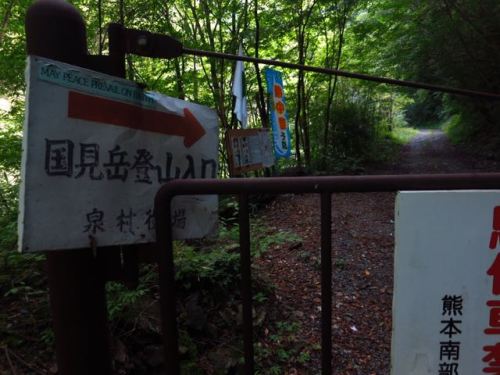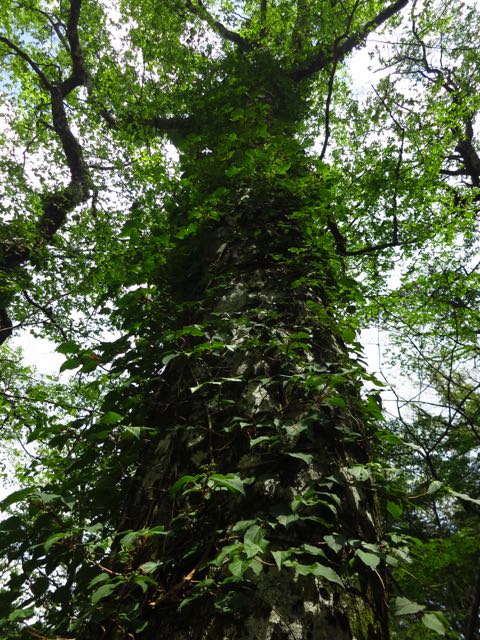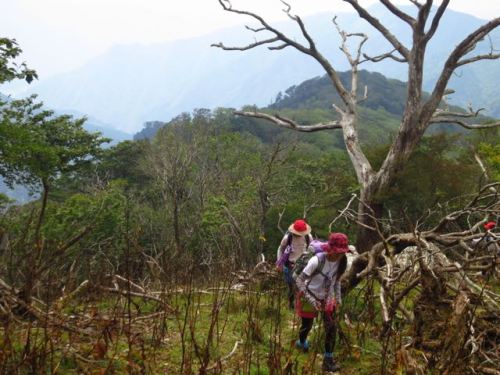2014 was an explosive year for volcanic activity on Japan’s mountains. While worldwide attention was focused on the catastrophic eruption of Ontake in late September, an increase of seismic tremors under the Nakadake crater lake on Mt Aso caused a small scale eruption just two months later. This was the start of increased volcanic activity, culminating in the explosive 2016 discharge which sent billowing ash 11,000 meters into the sky, landing as far away as Kagawa on the island of Shikoku. Therefore, the last 6 years have caused a quagmire for the Hyakumeizan hunters, who would either need to break the rules or put their quest on hold before knocking off their final peak.

As a Hyakumeizan alumnus, I do my job to help out a few disciples by offering a bit of advice and, on occasion, an extra set of eyes and ears as I accompany them on their journey up the hallowed peaks. So when Alastair informs me that the restrictions on Mt Aso have now been lifted, I jump at the chance for a revisit to see exactly what nature has done to the peak. Such reopenings of trails on active volcanoes are usually short-lived, so it is definitely a now-or-never mentality as Alastair aims for peak #95 on his ever-shrinking list. Plus, he offers to do all of the logistics, including the driving to the trailhead. All I need to do is to board a train to Kyushu. Who could resist?
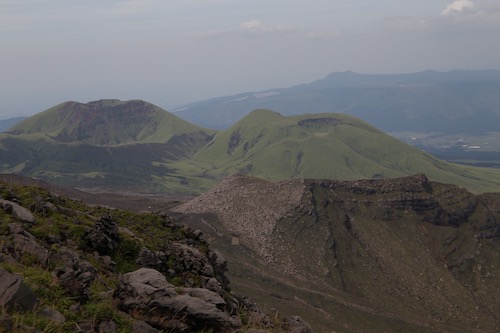
We pick up the rental car outside of Kumamoto station on a cloudless morning on the cusp of the Silver Week holiday. Japan has been on unofficial lockdown for most of the year due to the COVID-19 pandemic, but the government seems obsessed with saving the economy at the expense of public health and has introduced a ‘Go to Travel’ scheme that basically involves paying common citizens to travel in Japan. Thus, here we sit in gridlock as half of the island of Kyushu seems intent on visiting the volcano.

Most of the major roads leading through the interior of Kumamoto Prefecture are still being repaired due to 2016 earthquake, meaning there is no easy or fast way to get to Mt Aso. Backroads are rammed bumper-to-bumper with slow-moving vehicles that edge their way along the edge of the outer rim of the volcanic crater, which has a circumference of nearly 114km, making it one of the largest in the world. 90% of the traffic is heading up towards Kusasenri and Nakadake crater, where overpriced restaurants and horse-riding attract throngs of tourists who have mostly kept their distance for the last 6 years. Once past the turnoff, traffic becomes much lighter. While there is a trailhead at Nakadake crater, we opt for the northern approach via Sensuikyo, the trailhead furthest from the active crater. If Aso decides to blow its nose, we have the best chance of survival.
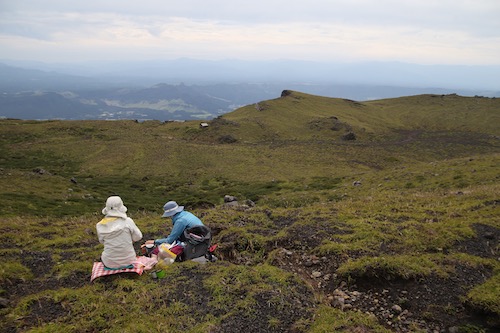
The parking lot is crammed with cars as Alastair secures one of the last empty spaces just after 10am: we had hoped to be on the trail at least an hour earlier, but had not anticipated the traffic. The information center sits dark, shuttered behind locked doors that have likely been gathering dust for at least half a decade. The small toilet complex is unlocked and has fortunately seen a recent cleaning. The slopes just above the restroom are littered with cables dangling from the concrete pillars of the old ropeway system. During my first visit 18 years ago, the gondola was very much still in operation, shuttling lazy hikers a third of the way up the volcano to the edge of the ridge line. There is definitely a post-Sarajevo Olympic vibe here, though the cause of such decay seems to be neglect rather than war.

A path leads straight up the slopes and parallels the ropeway ruins, and it is this concrete path that I used on my first trip to the volcano, but during that time I became intrigued with another route called the Sensui-one spur that climbs a steep ridge just under the Takadake high point. It is along this route that Alastair and I now turn our attention. The trailhead entrance lies on the opposite side of the car park, marked with a small wooded bridge spanning the Sensui ravine. Along broken bits of concrete we initially prance, followed by a narrow path recently cleared of underbrush. The start of the spur is soon reached, offering a refreshing bit of rock-hopping along the weather-beaten pumice.

A generous lathering of yellow arrows delineates the route, but in the overcast autumn skies we can clearly trace the path all the way up to the summit plateau towering 600 vertical meters above. As we climb higher, the vistas across the valley behind us open up to the Kujū mountains rising majestically out of the fertile valley. A giant white stupa constructed near the trailhead feel distinctly southeast Asian, perhaps even Burmese in nature if someone would be kind enough to bring a truckload of gold paint.

Alastair and I make good work of the spur, powered by a self-imposed race against the volcanic gods. One sudden tremor or plume of steam on the horizon would mean a sudden abandonment of our climb and a quick scramble for shelter. Loitering on an active volcano is something that no one should do unnecessarily, so while our plan is to enjoy the hike, we keep the pace brisk and the rests brief.

It takes around 90 minutes to reach the Takadake crater rim – stretched out before us is an older, dormant crater lined with verdant grasses and affording stellar views across to Mt Sobo and Mt Okue to the east. Crisp autumn winds push in from the north, keeping us moving up the final few steps of the pyramidal form of Takadake. A few dozen other hikers lounge around on the summit, while the buzz of a drone pierces the still air. At least the lack of tranquility will (literally) keep us on our toes.
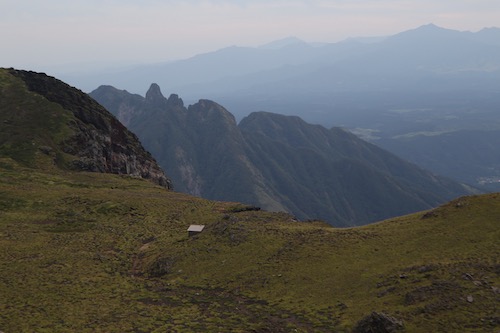
We pick up the track down to a saddle below Nakadake, where the gentle gradient brings thoughts of the Scottish hills to mind. The route takes us towards the active crater of Nakadake, which seems a bit like slipping out of the frying pan and into the fire, but an unforeseen force attracts us towards the pillar of steam billowing from the giant crater.

Continuing south, the first signs of the eruptions present themselves, as the entire landscapes takes on a tinge of brownish-gray dust, staining the signposts as if crafted by a spray gun artist. We are now within the 1km strike zone, an area that no other hikers have visited apart from the several dozen other trespassers staring in goggle-eyed disbelief.
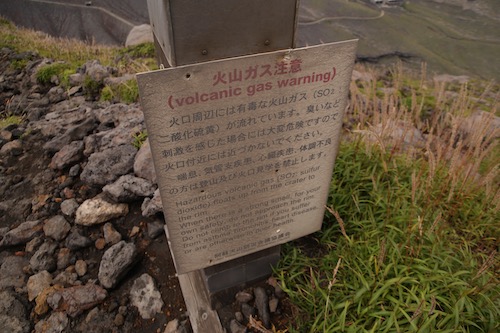
The track drops to a narrow saddle and climbs to an overlook uncomfortably close to the active crater, but we push on, spellbound and transfixed like a veteran rubbernecker. Gazing directly down into the hissing crater, I wonder how long it will be before this vista will once again be off limits to all but the most dedicated volcanic researchers.
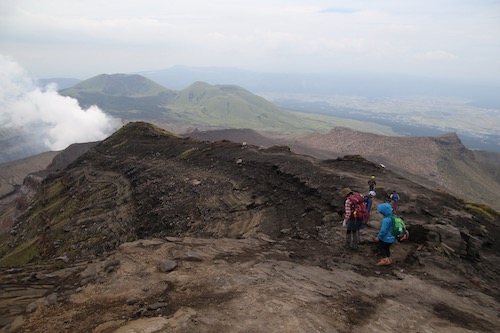
I turn around and trace my eyes up along the ridge we had just traversed, with the top hat of the Nakadake summit teetering on the edge of the abyss. A pair of concrete bunkers sit just off the ridge, partially collapsed by the force of the series of powerful eruptions. While these emergency shelters offer protection from small stones, a cataclysmic eruption of the crater would perhaps allow you enough time to send a farewell text to a loved one.

A concrete path used to run from here to the top of the ropeway, but now it is nothing but the remnants of rain runoff with bits of cement piercing through the fresh layer of ash. We reach the top of the ropeway ruins, a structure that would probably have received less damage had it actually been hit by bombs. Perhaps the Nakadake crater showed its discontent by trying to wipe this eyesore off the face of the earth.

Luckily for visitors, the ropeway ceased operations in 2010, meaning no one was actually in the structure during the series of volcanic explosions. While this building may seem like a wet dream for the haikyo hunters, visitors are advised to stay well clear of the incredibly unstable structure, which seems hellbent on collapse with nothing more than a strong gale.

The concrete path that runs alongside the ropeway is slowly being taken by the forces of nature, making the path rather pleasant among the tufts of greenery swallowing the remaining remnants of surfaced walkway. We follow a handful of other hikers down the rolling slopes towards the parking lot.

It would make for a peaceful end to our hike if not for the thumping crescendo of an approaching helicopter. The chopper heads above the summit of Takadake, where a lone figure is winched down to the ground. In conjunction, a sextet of rescue workers ascends at a brisk pace to offer back-up. The lead is connected via radio to the chopper team, who are in the midst of a rescue operation. We give way to the team, offering words of encouragement for what will likely be the first of many missions on this busy holiday weekend.
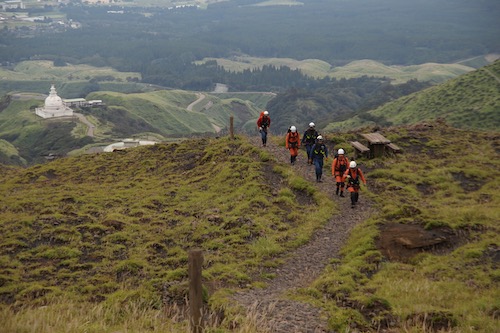
Once back at the car, we final exhale a sigh of relief. Alastair can now count the remaining Hyakumeizan on one hand and now has everything west of the Japan Alps off his list. Just one peak in Hokkaido, one in Tohoku, and a trio of peaks in the South Alps stand between him and his goal of finishing the 100.


